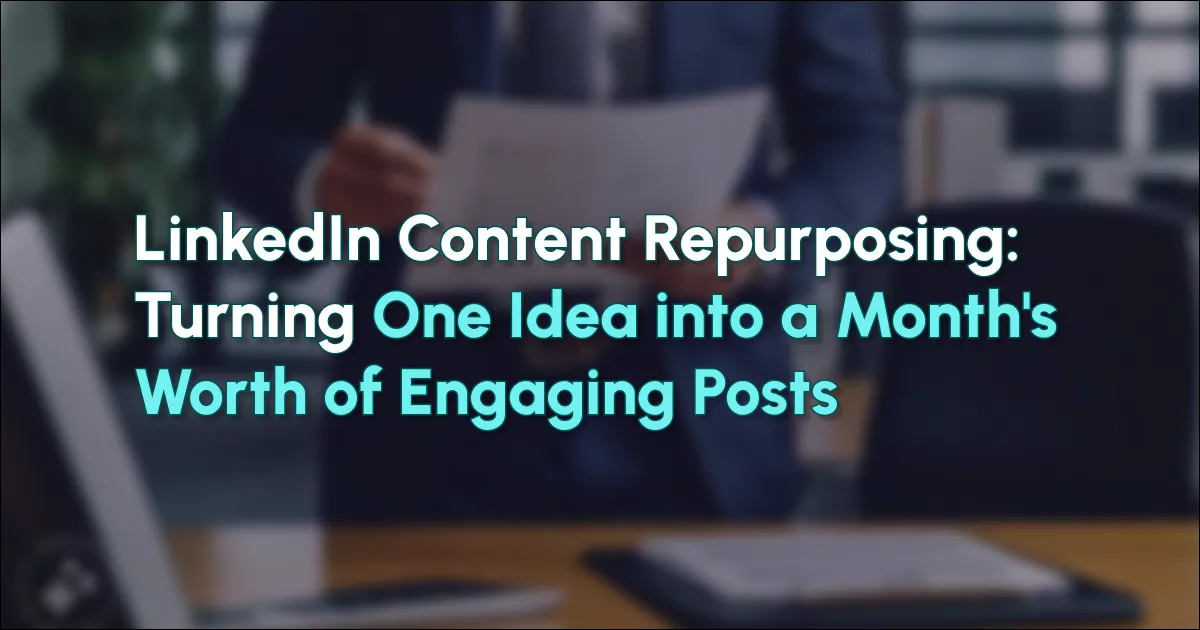
If you're creating content from scratch every day, it's kind of like ... baking your own bread. I mean, I see the appeal but why?
Fact of the matter is: It's hard creating content from scratch. You're almost never going to be consistent with it if you do it that way and consistency matters more than perfection.
The good news is: Repurposing works. It works really well. Your best posts from a month ago can still be a hit.
The secret: it's not about recycling the same content – it's about extracting maximum value from each insight. As always, here's the deep-dive with straight-up actionable advice/templates (I value your time, dear reader):
The Content Multiplication Framework
Core Idea Expansion
Original Idea → Multiple Angles → Different Formats → Various Contexts
Example Core Idea:
"How we reduced customer churn by 47%"
Becomes:
• Case study
• How-to guide
• Lessons learned
• Industry analysis
• Team perspective
• Client testimonial
• Process breakdown
• Results deep-dive
The 1-to-30 Content Matrix
Week 1: Foundation Content
Day 1: Core Story Post
"How we reduced customer churn by 47% in 90 days"
Day 2: Data Breakdown
"The 3 metrics that predicted churn"
Day 3: Process Post
"The exact steps we took to identify churn risks"
Day 4: Team Perspective
"What our support team learned about retention"
Day 5: Customer Insight
"The surprising feedback that changed everything"
Week 2: Deep Dives
Day 6: Tool Analysis
"The tech stack behind our churn reduction"
Day 7: Cost Breakdown
"Investment vs. Return in churn reduction"
Day 8: Timeline Post
"Month-by-month progress in reducing churn"
Day 9: Challenge Post
"The biggest obstacles we faced"
Day 10: Solution Post
"How we overcame each challenge"
Week 3: Lessons & Applications
Day 11-15: Individual Lessons
• Monday: Strategy lessons
• Tuesday: Implementation lessons
• Wednesday: Team lessons
• Thursday: Customer lessons
• Friday: Industry lessons
Week 4: Alternative Angles
Day 16-20: Different Perspectives
• Customer success story
• Team member spotlight
• Industry comparison
• Future implications
• Behind-the-scenes
Content Transformation Templates
1. The Story-to-Series Template
Original Story:
[Core narrative]
Breaks into:
1. The Challenge Post
2. The Process Post
3. The Results Post
4. The Lessons Post
5. The Implementation Post
2. The Data-to-Insights Template
Original Data Point:
[Key statistic]
Transforms into:
1. Visual representation
2. Industry comparison
3. Trend analysis
4. Future prediction
5. Action steps
3. The Process-to-Posts Template
Original Process:
[Step-by-step guide]
Becomes:
1. Overview post
2. Individual step deep-dives
3. Common mistakes
4. Success factors
5. Implementation tips
Content Format Variations
1. Narrative Formats
• Success story
• Failure lesson
• Behind-the-scenes
• Customer journey
• Team perspective
2. Educational Formats
• How-to guide
• Tutorial series
• Tip collection
• Resource list
• Framework explanation
3. Analytical Formats
• Data analysis
• Trend report
• Industry insight
• Market comparison
• Performance review
Content Optimization Strategy
1. Format Optimization
Original Post → Multiple Formats:
• Story version
• List version
• Question version
• Challenge version
• Tutorial version
2. Angle Variation
Same Content, Different Perspectives:
• Business angle
• Personal angle
• Industry angle
• Customer angle
• Future angle
The Content Repurposing Workflow
1. Content Extraction Process
Step 1: Core Idea Documentation
- Main insight
- Key data points
- Critical lessons
- Unique perspectives
Step 2: Angle Identification
- Business implications
- Personal lessons
- Industry impact
- Customer benefits
Step 3: Format Planning
- Post types
- Content structure
- Engagement hooks
- Call-to-actions
2. Content Calendar Planning
Week 1: Primary Content
- Core message
- Main angles
- Key stories
Week 2: Deep Dives
- Detailed analysis
- Specific examples
- Case studies
Week 3: Applications
- Practical tips
- Implementation guides
- Action steps
Week 4: Perspectives
- Different viewpoints
- Alternative approaches
- Future implications
Frequently Asked Questions
Won't my audience notice repeated content?
When done right, repurposed content provides new value from different angles. Only 2% of your audience sees all your posts.
How do I keep repurposed content fresh?
Add new insights, current context, and different perspectives to each piece of repurposed content.
What's the ideal mix of new vs. repurposed content?
Aim for 70% repurposed, 30% new content. This ensures consistency while maintaining freshness.
How do I track what content to repurpose?
Monitor engagement metrics to identify high-performing content worth repurposing.
Scale Your Content Repurposing
Creating multiple high-quality posts from one idea takes strategic thinking. LiGo helps you:
-
Generate multiple angles from one idea
-
Create varied content formats
-
Rewrite your best performing posts without sounding the same
-
Stay consistent
Try our Premium plan for unlimited content generation and repurposing ideas – perfect for professionals looking to maximize their content efficiency.




